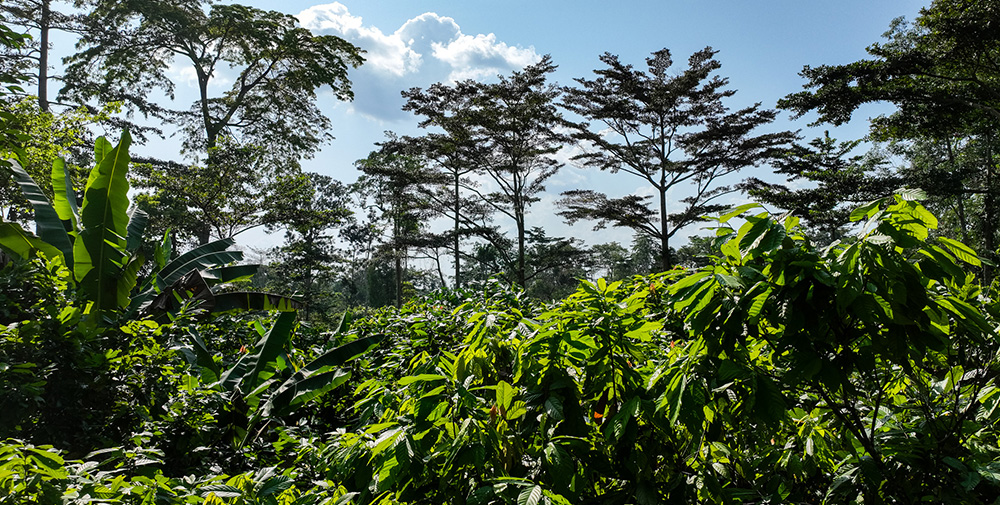Material topic
- Emissions
Climate
Science-based targets
In 2023, our science-based targets were validated by the Science Based Targets initiative (SBTi). We announced these at the end of 2023, together with a high-level roadmap outlining first actions to achieve our goals. SBTi is a global body enabling businesses to set ambitious emission reduction targets in line with the latest climate science. It is focused on accelerating companies across the world to halve emissions before 2030 and achieve net-zero emissions before 2050. The initiative is a collaboration between CDP, the United Nations Global Compact, World Resources Institute (WRI), and the World Wide Fund for Nature (WWF). The SBTi call to action is also one of the We Mean Business Coalition commitments. The SBTi defines and promotes best practice in science-based target setting, offers resources and guidance to reduce barriers to adoption, and independently assesses and approves companies’ targets. Based on their methodology, Lindt & Sprüngli has set targets for its direct and indirect emissions (Scopes 1 and 2), as well as for emissions from the up- and downstream value chain (Scope 3), including elements of the value chain relating to Forest, Land and Agriculture (FLAG). Our targets are focused on achieving an absolute reduction in emissions by 2030 and 2050, using 2020 as our baseline.
Our science-based targets and roadmap at a glance
Lindt & Sprüngli has approved near- and long-term science-based emissions reduction targets with the SBTi. The SBTi has also verified Lindt & Sprüngli’s net-zero science-based target by 2050. Lindt & Sprüngli commits to the following targets:
- Scopes 1 & 2: Lindt & Sprüngli commits to reduce absolute scope 1 and 2 GHG emissions 42% by FY2030 and 90% by FY2050 from a FY2020 base year1.
- Scope 3 non-FLAG: Lindt & Sprüngli commits to reduce absolute scope 3 GHG emissions 25% by FY2030 and 90% by FY2050 from a FY2020 base year.
- Scope 3 FLAG: Lindt & Sprüngli commits to reduce absolute scope 3 FLAG GHG emissions 30.3% by FY2030 and 72% by FY2050 from a FY2020 base year2. Lindt & Sprüngli commits to no deforestation across its primary deforestation-linked commodities, with a target date of December 31, 20253.
- Net-zero: Lindt & Sprüngli commits to reach net-zero greenhouse gas emissions across the value chain by 2050.

Our near- and long-term targets aim for absolute emission reductions by 2030 and 2050. These are measured against our 2020 baseline, with an ultimate goal to be at net-zero emissions by 2050. We will prioritize decarbonization efforts and neutralize all residual emissions to reach our goals. In 2022, we laid the foundations for our decarbonization roadmap, which we continued to refine throughout 2023. This roadmap provides insights into where to focus our decarbonization efforts and helps determine prioritization of emission reduction actions across the Group. These assessments, as well as inputs from internal and external experts, indicate that our emission-reduction opportunities with the most potential lie in the cocoa value chain. These include focusing on a deforestation-free network of supply and helping farmers to conduct more environmentally responsible agricultural practices. Collaboration with other raw material suppliers, and consideration of possible reduction of, or alternatives to, high-emitting raw materials such as milk, are also likely to contribute constructively to GHG reduction. Both approaches will ultimately help us achieve our Scope 3 FLAG targets. Our FLAG commitments also include a no-deforestation commitment in our primary deforestation-linked raw material, cocoa.
The second largest areas of opportunity for emission reduction are packaging and transportation. We address specific and relevant actions through our Sustainable Packaging Initiative, such as designing packaging for recyclability and finding packaging alternatives. In the supply chain, we plan to work with logistics suppliers to find lower-carbon transport options, or optimize the distance traveled or amount loaded per transport. These and other efforts will also help to reduce emissions against our other Scope 3 targets.
We are already using some low-carbon energies and aim to expand this usage in our direct operations. Simultaneously, we are assessing how we could potentially reduce energy consumption overall by improved efficiency in our factories, which typically emit most of our emissions in the Scope 1 and 2 categories.
All of these types of actions are of equal importance as we need to reach all SBTs individually. Some actions are already in progress, while others will take longer to prepare and implement. Ultimately, we have to make decisions that drive the decarbonization of our value chain as part of normal day-to-day business operations.
Roadmap progress in 2023
In 2023, we started working with an external expert to help translate our global decarbonization roadmap into actionable plans. We established local decarbonization action plan suggestions for all companies in our Group and onboarded several teams to this new approach. The onboarding involves multi-disciplinary local teams assessing the plan suggestions and establishing concrete sub-targets and plans for execution. Please also refer to our Roadmap to net-zero.
|
|
|
|
Retrospective |
|
Targets |
||||||||||||
|
|
Unit |
|
Base year (2020) |
|
Comparative (Actuals 2022) |
|
Comparative (Estimates 2023) |
|
%N/N-1 |
|
2030 |
|
2050 |
||||
|
|
|
|
|
|
|
|
|
|
|
|
|
|
|
||||
Scope 1 & 2 GHG emissions |
||||||||||||||||||
Gross direct (Scope 1 & Scope 2 market-based) |
|
t CO2 eq |
|
174,235 |
|
164,276 |
|
154,891* |
|
–5.7% |
|
101,056 |
|
17,424 |
||||
|
|
|
|
|
|
|
|
|
|
|
|
|
|
|
||||
Significant Scope 3 GHG emissions |
||||||||||||||||||
Gross other indirect (Scope 3) GHG emissions (GRI 305-3) |
|
t CO2 eq |
|
2,980,983 |
|
3,562,878 |
|
3,545,877* |
|
–0.5% |
|
|
|
|
||||
of which FLAG |
|
t CO2 eq |
|
2,129,281 |
|
2,534,465 |
|
2,516,522 |
|
–0.7% |
|
1,484,109 |
|
596,199 |
||||
of which non-FLAG |
|
t CO2 eq |
|
851,702 |
|
1,028,413 |
|
1,029,355 |
|
0.1% |
|
638,777 |
|
85,170 |
||||
|
|
|
|
|
|
|
|
|
|
|
|
|
|
|
||||
Total GHG emissions |
||||||||||||||||||
Total GHG emissions |
|
t CO2 eq |
|
3,155,218 |
|
3,727,154 |
|
3,700,768* |
|
–0.7% |
|
2,122,885 |
|
681,369 |
||||
|
||||||||||||||||||
Our carbon footprint
Our total GHG emissions (Scopes 1, 2, and 3) in 2023 were 3.7 million tonnes CO2 equivalent. This is an increase compared to our 2020 baseline of around 17%, mainly due to growth-related volume increases and an increase in purchased raw materials some of which have a higher footprint. Emissions from our value chain (Scope 3) represent around 96% of our carbon footprint, with cocoa, other raw materials (such as dairy), transport, and packaging being the largest contributors. Our business relies on agricultural commodities from around the globe, so agricultural activities and related land-use change (e.g., deforestation) and the processing and transport of these raw materials all contribute significantly to Lindt & Sprüngli’s global emissions.
Division of our footprint (2023) into emissions scopes and main impact categories

Scope 1 & 2 emissions – progress
Scope 1 and 2 emissions from energy consumption in production, warehousing, offices, and retail operations contribute around just over 4% to our total emissions. They mainly stem from heating, cooling, and electricity usage in chocolate production. In line with the LPW (see Lindt Performance Way), our International Operations team sets and reviews targets and actions bi-annually. Furthermore, the cumulative effect of specific emissions reduction actions and targets will be assessed on an annual basis by our Group Management.
Our emission reduction initiatives at production sites included optimizing heating, ventilation, and air conditioning systems, replacing refrigeration units and fluids, improving the insulation of piping systems, and using low-carbon energy. Additionally, some of our sites use certified management systems (ISO 140001 in Italy and ISO 50001 in Germany) to improve their environmental management and energy efficiency. In 2023, we slightly increased direct energy use compared to 2022, but overall had a small decline in Scope 1 emissions, driven mainly by a small reduction in natural gas and refrigerants usage. We decreased indirect energy use which led to a drop in Scope 2 emissions. Compared to our 2020 baseline, we have decreased our Scope 1 and 2 emissions by around 11%. We expect that with the implementation of our local decarbonization plans across all our local companies, we will be able to make significant steps to reduce these emissions in the near term.
Scope 3 emissions – progress
Our Scope 3 emissions increased by 19% compared to our 2020 baseline. We recognize this is not in line with the direction that we should pursue to meet our science-based targets. However, we also recognize that this increase occurred in a period when we were focusing efforts to improve key processes and tools to accurately report our footprint and developing concrete action plans to tackle emissions in both Scope 3-FLAG and Scope 3-non-FLAG related areas. The emissions increase was mainly driven by production and sales growth. As part of our decarbonization roadmap development, we have also identified specific actions that are coordinated more centrally and aim to tackle significant parts of our footprint, such as cocoa and other raw materials.
We aim to report further details on our 2023 progress in the CDP Climate framework, using year-end data.
Task Force on Climate-Related Financial Disclosures (TCFD) Outlook
In 2023, we completed a TCFD gap assessment with the help of a third party. This analysis showed that our metrics and targets are generally meeting the requirements for having a TCFD-aligned disclosure, further aided by the announcement of our SBTs. Improvement areas were identified in the areas of climate governance, strategy, and risk management.
As a first step, in 2023 we further detailed governance of climate-related risks and opportunities, with the aim of making our employees everywhere responsible for considering lower-carbon decisions in their daily work. This reaches from the Board and Group Management, to operational and functional departments worldwide, and soon to designated greenhouse gas (GHG) responsible persons in our subsidiaries. We evaluated business processes and practices so that departments will be equipped to execute defined interventions in the future, and set associated sub-targets. We expect that in the short term, other business processes may change to help further integrate emission-reduction priorities in our company. For details on our climate-related governance, please refer to our Roadmap to net-zero.
We are planning to conduct a (high-level) assessment of physical and transitional risk exposures in early 2024, with the support of a third party. This assessment will take into account different climate scenarios, including a 2°C or lower scenario, to better understand the potential risks and opportunities of climate change to our business, strategy, and financial planning.
We aim to provide further insights into these assessments in next year’s report.
1 13 The target boundary includes biogenic emissions and removals from bioenergy feedstocks.
2 14 Targets include FLAG emissions and removals.
3 15 Lindt & Sprüngli has identified cocoa to be its primary deforestation-linked commodity.
